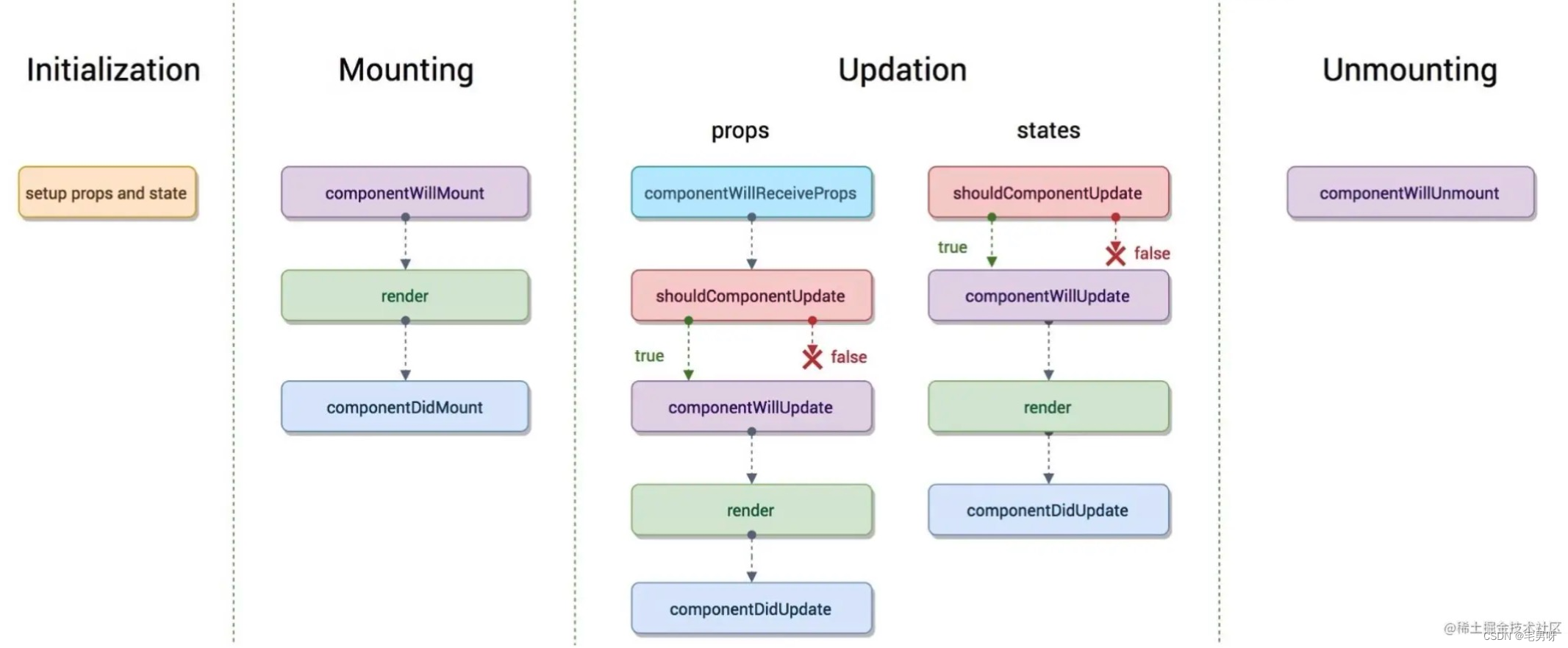生命周期变化
- React 从 v16.3 开始,对生命周期进行了渐进式的调整。废弃了一些生命周期方法和添加了一些新的生命周期方法。
Add a new getDerivedStateFromProps() lifecycle and UNSAFE_ aliases for the legacy lifecycles.
Add a new getSnapshotBeforeUpdate() lifecycle.
React 逐渐废弃的生命周期方法
componentWillMount
componentWillReceiveProps
componentWillUpdate
v16.3虽然废弃了这几个生命周期方法,但是 React 为了遵循版本兼容,所以并没有删除这三个方法,并且还增加了UNSAFE_componentWillMount,UNSAFE_componentWillReceiveProps和UNSAFE_componentWillUpdate方法,在 v16.3 版本中 新旧这几个方法都可以使用。
在 v16.3 以后的 v16.x版本中,新旧的方法依旧都可以使用,但是使用不带UNSAFE_前缀的方法,将提示被弃用的警告。
在v17 将删除componentWillMount,componentWillReceiveProps和componentWillUpdate,只有带有UNSAFE_前缀新的生命周期方法可以使用。
react生命周期(v16.3之前-旧)
生命周期: 在生成组件这个实例时,不同的时间阶段会默认调用一些函数;这些钩子函数就是生命周期函数;
这个生命周期钩子函数可以让生成实例的过程中,让咱们可以添加一些自己的逻辑;
页面第一次加载:
defaultProps==> constructor ==> componentWillMount ==> render ==> componentDidMount
页面数据更新:
shouldComponentUpdate==>componentWillUpdate==> render==>componentDidUpdate
生命周期的顺序:
defaultProps==> constructor ==> componentWillMount ==> render ==> componentDidMount==> componentWillUnmount
当组件的属性或state发生改变以后,都会触发视图的更新
componentWillReceiveProps(){
// 第一次解析时不执行,当后面的属性发生改变,就会执行这个钩子函数;
console.log(“子组件:componentWillReciveProps”)
}
import React from "react";
import ReactDOM from "react-dom";
// 生命周期: 在生成组件这个实例时,不同的时间阶段会默认调用一些函数;这些钩子函数就是生命周期函数;
// 这个生命周期钩子函数可以让生成实例的过程中,让咱们可以添加一些自己的逻辑;、
class Parent extends React.Component{
static defaultProps={
abc:"China"
}
// constructor 和 render都是react生命周期的一个钩子函数;
constructor(props){
super(props);
//1. 一般在constructor 初始化状态 2. 也可以获取到外界传递进来的属性
console.log("contructor")
this.state={num:66}
//console.log(this.props.abc)
}
componentWillMount(){
// 组件挂载之前,会执行这个钩子函数;可以在这个钩子函数中修改状态,当render渲染时,直接获取到最新的状态,不用再次调用render了;
// 在render之前把数据改掉,不会再次出发render;
console.log("componentWillMount")
this.setState({num:88});
}
componentDidMount(){
// 当组件挂载完成之后执行的钩子函数
console.log("componentDidMount");
}
shouldComponentUpdate(nextProps,nextState){
// 在componentWillUpdate之前执行
// 这个钩子函数中return true,会继续向下更新执行;如果return false,不再触发下面的钩子函数
// 这个钩子函数经常用于react性能优化;在视图或数据更新之前,加了一层拦截,返回true,就继续更新,
返回false,不更新
// nextProps : 代表下一次的属性 nextState: 代表下一次的状态
//console.log(nextState)
// console.log(nextProps.abc)
// 可以根据下一次props或state值判断是否要刷新视图;如果需要返回true,不需要返回false;
// 第一个参数: 代表的是下一次的属性
// 第二个参数: 代表的是下一次的状态
// console.log("shouldComponentUpdate");
// if(nextState.num%2===0){
// return true
// }else{
// return false;
// }
return true;
}
componentWillUpdate(){
// 当属性或状态发生改变,会引发视图的更新,同时也会调用这个钩子函数,在render之前
console.log("componentWillUpdate")
}
componentDidUpdate(){
// 组件更新后
console.log("componentDidUpdate")
}
componentWillUnmount(){
// 组件卸载
console.log("componentWillUnmount")
}
add=()=>{
this.setState({num:this.state.num+1})
// 卸载元素root上的组件
// ReactDOM.unmountComponentAtNode(document.querySelector("#root"));
}
render(){
console.log("render")
// 会返回一个react元素,而且只能有一个根元素;这个返回的元素最终会渲染到root元素中
// 调用一次setState就会执行一次render;默认也会执行一次
return <div>
{this.state.num}
<button onClick={this.add}>新增</button>
<Child val={this.state.num}></Child>
</div>
}
}
// 页面第一次加载defaultProps==> constructor ==> componentWillMount ==> render ==>
componentDidMount
// 页面数据更新:shouldComponentUpdate==>componentWillUpdate===> render==>componentDidUpdate
// 生命周期的顺序:defaultProps==> constructor ==> componentWillMount ==> render ==>
componentDidMount==> componentWillUnmount
// 当组件的属性或state发生改变以后,都会触发视图的更新
class Child extends React.Component{
constructor(){
super();
console.log("子组件:constructor")
}
componentWillReceiveProps(){
// 第一次解析时不执行,当后面的属性发生改变,就会执行这个钩子函数;
console.log("子组件:componentWillReciveProps")
}
// 当父组件数据更新时,父组件执行重新渲染函数render时,这三个钩子函数也会跟着执行,
不过父组件componentDidUpdate最后执行;
shouldComponentUpdate(){
console.log("子组件:shouldComponentUpdate");
return true;
}
componentWillUpdate(){
console.log("子组件:componentWillUpdate")
}
componentDidUpdate(){
console.log("子组件:componentDidUpdate")
}
render(){
console.log("子组件: render")
return <div>
子组件:{this.props.val}
</div>
}
}
ReactDOM.render(<Parent time="20200311" abc="中国"></Parent>,document.getElementById("root"));
生命周期图


react生命周期(v16.3以后-新)
生命周期图























 1万+
1万+











 被折叠的 条评论
为什么被折叠?
被折叠的 条评论
为什么被折叠?








